Auditing 1: Analyzing Qantas - Key Issues and Problems in an Audit
VerifiedAdded on 2022/11/15
|6
|1280
|94
Report
AI Summary
This report provides an analysis of Qantas, focusing on its core business operations within the airline industry, and the inherent risks involved. It examines Qantas's financial performance, including revenue, profitability, and key financial metrics compared to the overall industry trends. The report highlights the company's segments, such as Qantas Domestic, Qantas International, and Jetstar, as well as the factors influencing its growth and performance. Furthermore, it discusses key business risks, including financial risks related to currency fluctuations, cyber security threats, and the impact of external factors such as fuel costs. The analysis incorporates data from the Qantas Annual Report 2018 and other sources to provide a comprehensive overview of the company's financial health and operational challenges.
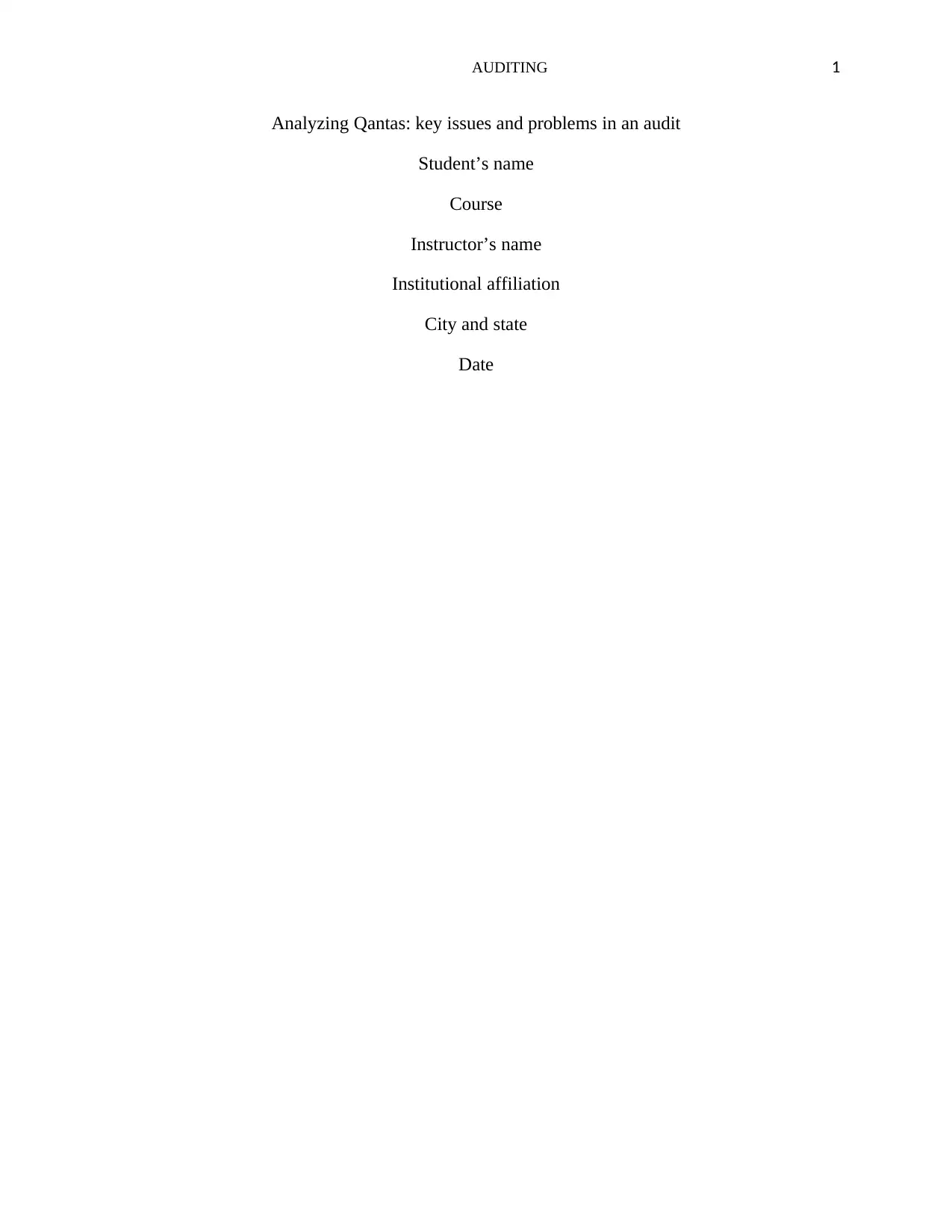
AUDITING 1
Analyzing Qantas: key issues and problems in an audit
Student’s name
Course
Instructor’s name
Institutional affiliation
City and state
Date
Analyzing Qantas: key issues and problems in an audit
Student’s name
Course
Instructor’s name
Institutional affiliation
City and state
Date
Paraphrase This Document
Need a fresh take? Get an instant paraphrase of this document with our AI Paraphraser
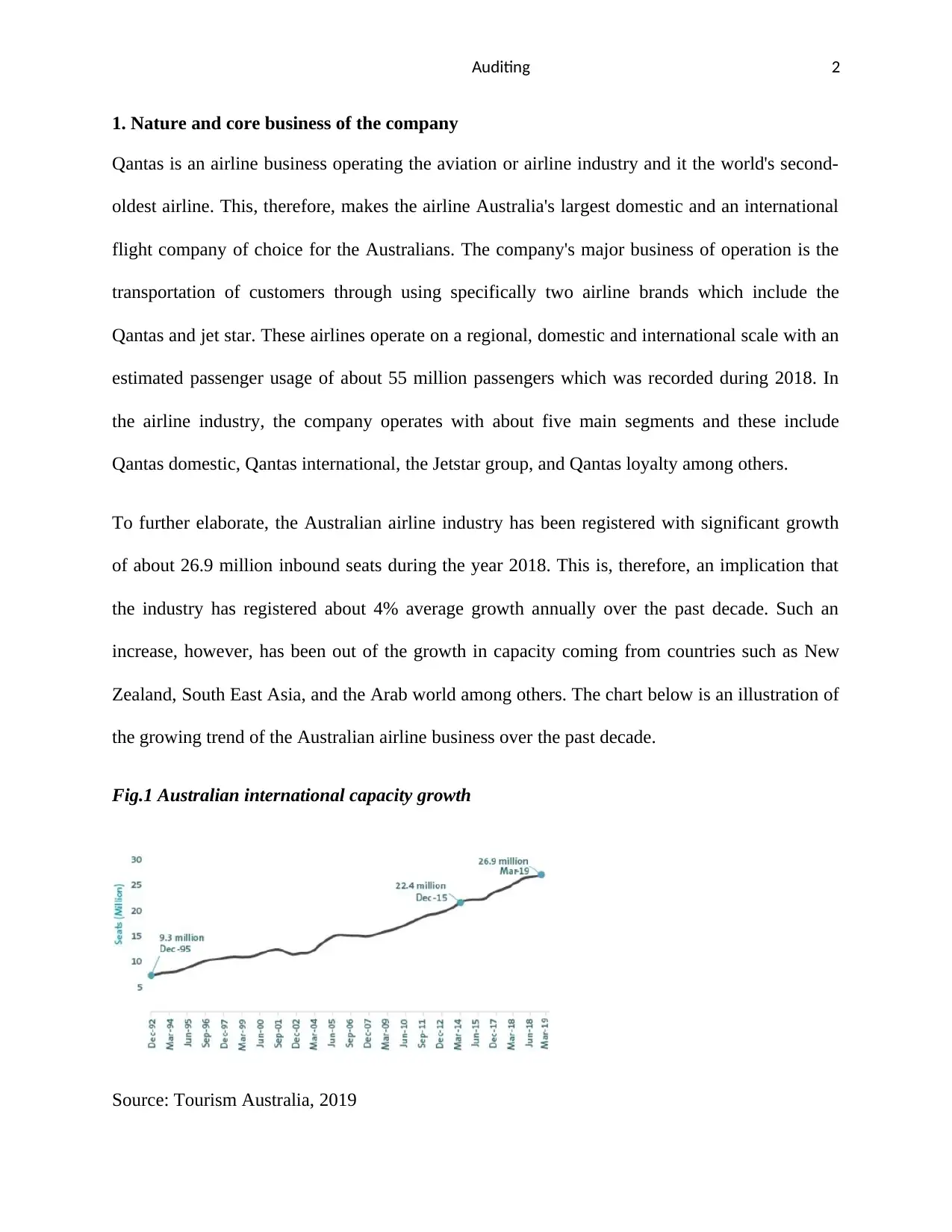
Auditing 2
1. Nature and core business of the company
Qantas is an airline business operating the aviation or airline industry and it the world's second-
oldest airline. This, therefore, makes the airline Australia's largest domestic and an international
flight company of choice for the Australians. The company's major business of operation is the
transportation of customers through using specifically two airline brands which include the
Qantas and jet star. These airlines operate on a regional, domestic and international scale with an
estimated passenger usage of about 55 million passengers which was recorded during 2018. In
the airline industry, the company operates with about five main segments and these include
Qantas domestic, Qantas international, the Jetstar group, and Qantas loyalty among others.
To further elaborate, the Australian airline industry has been registered with significant growth
of about 26.9 million inbound seats during the year 2018. This is, therefore, an implication that
the industry has registered about 4% average growth annually over the past decade. Such an
increase, however, has been out of the growth in capacity coming from countries such as New
Zealand, South East Asia, and the Arab world among others. The chart below is an illustration of
the growing trend of the Australian airline business over the past decade.
Fig.1 Australian international capacity growth
Source: Tourism Australia, 2019
1. Nature and core business of the company
Qantas is an airline business operating the aviation or airline industry and it the world's second-
oldest airline. This, therefore, makes the airline Australia's largest domestic and an international
flight company of choice for the Australians. The company's major business of operation is the
transportation of customers through using specifically two airline brands which include the
Qantas and jet star. These airlines operate on a regional, domestic and international scale with an
estimated passenger usage of about 55 million passengers which was recorded during 2018. In
the airline industry, the company operates with about five main segments and these include
Qantas domestic, Qantas international, the Jetstar group, and Qantas loyalty among others.
To further elaborate, the Australian airline industry has been registered with significant growth
of about 26.9 million inbound seats during the year 2018. This is, therefore, an implication that
the industry has registered about 4% average growth annually over the past decade. Such an
increase, however, has been out of the growth in capacity coming from countries such as New
Zealand, South East Asia, and the Arab world among others. The chart below is an illustration of
the growing trend of the Australian airline business over the past decade.
Fig.1 Australian international capacity growth
Source: Tourism Australia, 2019
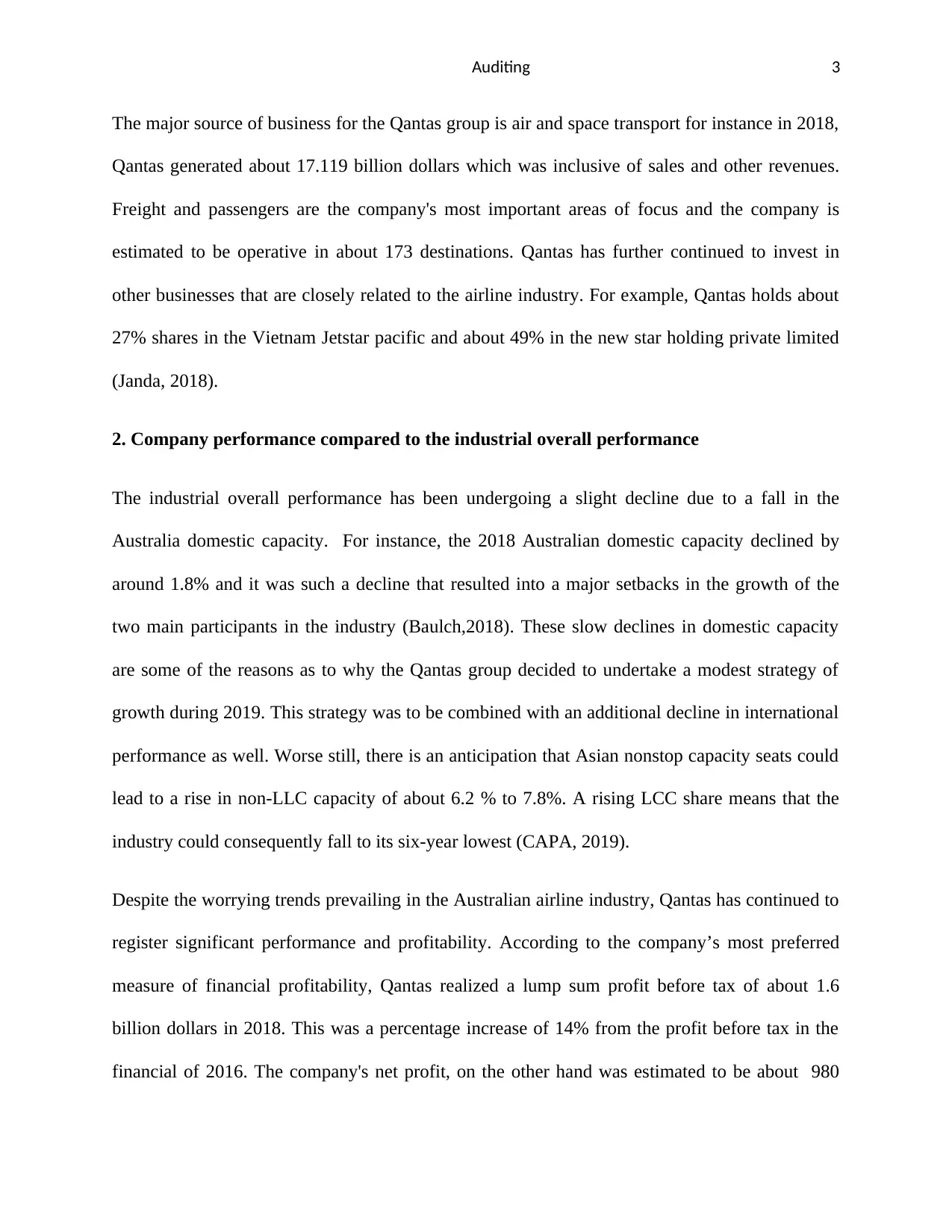
Auditing 3
The major source of business for the Qantas group is air and space transport for instance in 2018,
Qantas generated about 17.119 billion dollars which was inclusive of sales and other revenues.
Freight and passengers are the company's most important areas of focus and the company is
estimated to be operative in about 173 destinations. Qantas has further continued to invest in
other businesses that are closely related to the airline industry. For example, Qantas holds about
27% shares in the Vietnam Jetstar pacific and about 49% in the new star holding private limited
(Janda, 2018).
2. Company performance compared to the industrial overall performance
The industrial overall performance has been undergoing a slight decline due to a fall in the
Australia domestic capacity. For instance, the 2018 Australian domestic capacity declined by
around 1.8% and it was such a decline that resulted into a major setbacks in the growth of the
two main participants in the industry (Baulch,2018). These slow declines in domestic capacity
are some of the reasons as to why the Qantas group decided to undertake a modest strategy of
growth during 2019. This strategy was to be combined with an additional decline in international
performance as well. Worse still, there is an anticipation that Asian nonstop capacity seats could
lead to a rise in non-LLC capacity of about 6.2 % to 7.8%. A rising LCC share means that the
industry could consequently fall to its six-year lowest (CAPA, 2019).
Despite the worrying trends prevailing in the Australian airline industry, Qantas has continued to
register significant performance and profitability. According to the company’s most preferred
measure of financial profitability, Qantas realized a lump sum profit before tax of about 1.6
billion dollars in 2018. This was a percentage increase of 14% from the profit before tax in the
financial of 2016. The company's net profit, on the other hand was estimated to be about 980
The major source of business for the Qantas group is air and space transport for instance in 2018,
Qantas generated about 17.119 billion dollars which was inclusive of sales and other revenues.
Freight and passengers are the company's most important areas of focus and the company is
estimated to be operative in about 173 destinations. Qantas has further continued to invest in
other businesses that are closely related to the airline industry. For example, Qantas holds about
27% shares in the Vietnam Jetstar pacific and about 49% in the new star holding private limited
(Janda, 2018).
2. Company performance compared to the industrial overall performance
The industrial overall performance has been undergoing a slight decline due to a fall in the
Australia domestic capacity. For instance, the 2018 Australian domestic capacity declined by
around 1.8% and it was such a decline that resulted into a major setbacks in the growth of the
two main participants in the industry (Baulch,2018). These slow declines in domestic capacity
are some of the reasons as to why the Qantas group decided to undertake a modest strategy of
growth during 2019. This strategy was to be combined with an additional decline in international
performance as well. Worse still, there is an anticipation that Asian nonstop capacity seats could
lead to a rise in non-LLC capacity of about 6.2 % to 7.8%. A rising LCC share means that the
industry could consequently fall to its six-year lowest (CAPA, 2019).
Despite the worrying trends prevailing in the Australian airline industry, Qantas has continued to
register significant performance and profitability. According to the company’s most preferred
measure of financial profitability, Qantas realized a lump sum profit before tax of about 1.6
billion dollars in 2018. This was a percentage increase of 14% from the profit before tax in the
financial of 2016. The company's net profit, on the other hand was estimated to be about 980
⊘ This is a preview!⊘
Do you want full access?
Subscribe today to unlock all pages.

Trusted by 1+ million students worldwide

Auditing 4
million dollars in the same financial year of 2018 (Australian Aviation, 2019). The total
company revenue was increased by 6.2 % to around 17.06 billion dollars. The earnings per share
dividends further reflect the sound performance of the company as it announced a dividend of 10
cents per share away from 3 cents per share of 2017. All such information is a clear illustration
that irrespective the ongoing industrial challenges and constraints, Qantas group is still
financially stable and performing viably.
The company financial statements were presented on a comparative basis of basis reporting
financial information. This type of reporting financial data requires that a company should
present financial records of more than one period. Qantas group used such a technique or method
for presenting the 2018 annual financial records alongside those of the year 2017. All company
financial figures are presented in million dollars as the level of precision and this is done to
enable and facilitate a quick understanding of the information provided in the report. However,
the most significant change identified in the report was that the Qantas freight segment has been
included in the Qantas international segment (Qantas Annual Report, 2018). This inclusion of the
freight segment is a result of the harmonized monitoring which is done by a single body known
as the CODM and the Qantas flying business group.
3. The key business and inherent risks in the airline industry
An inherent risk is defined as the possibility or threat that an omission of a material item will
occur within a company’s financial statements as a result of uncontrollable factors and such an
omission is not detected while carrying out the audit. For an airline industry, the risks are highly
inevitable; such risks include the presence of hidden and harmful acts of the industry. The airline
industry business is run on a wide scale involving a large number of people, connections and
million dollars in the same financial year of 2018 (Australian Aviation, 2019). The total
company revenue was increased by 6.2 % to around 17.06 billion dollars. The earnings per share
dividends further reflect the sound performance of the company as it announced a dividend of 10
cents per share away from 3 cents per share of 2017. All such information is a clear illustration
that irrespective the ongoing industrial challenges and constraints, Qantas group is still
financially stable and performing viably.
The company financial statements were presented on a comparative basis of basis reporting
financial information. This type of reporting financial data requires that a company should
present financial records of more than one period. Qantas group used such a technique or method
for presenting the 2018 annual financial records alongside those of the year 2017. All company
financial figures are presented in million dollars as the level of precision and this is done to
enable and facilitate a quick understanding of the information provided in the report. However,
the most significant change identified in the report was that the Qantas freight segment has been
included in the Qantas international segment (Qantas Annual Report, 2018). This inclusion of the
freight segment is a result of the harmonized monitoring which is done by a single body known
as the CODM and the Qantas flying business group.
3. The key business and inherent risks in the airline industry
An inherent risk is defined as the possibility or threat that an omission of a material item will
occur within a company’s financial statements as a result of uncontrollable factors and such an
omission is not detected while carrying out the audit. For an airline industry, the risks are highly
inevitable; such risks include the presence of hidden and harmful acts of the industry. The airline
industry business is run on a wide scale involving a large number of people, connections and
Paraphrase This Document
Need a fresh take? Get an instant paraphrase of this document with our AI Paraphraser
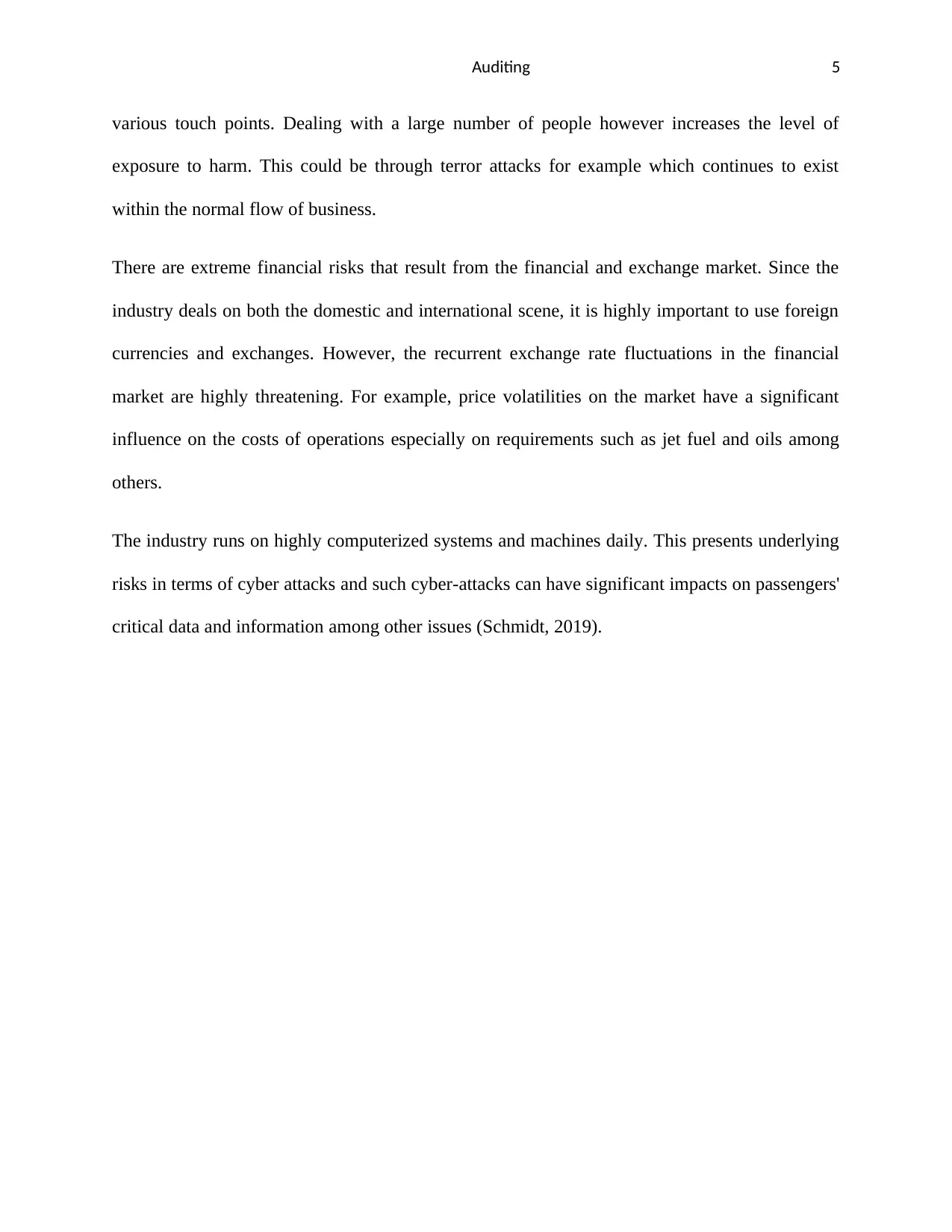
Auditing 5
various touch points. Dealing with a large number of people however increases the level of
exposure to harm. This could be through terror attacks for example which continues to exist
within the normal flow of business.
There are extreme financial risks that result from the financial and exchange market. Since the
industry deals on both the domestic and international scene, it is highly important to use foreign
currencies and exchanges. However, the recurrent exchange rate fluctuations in the financial
market are highly threatening. For example, price volatilities on the market have a significant
influence on the costs of operations especially on requirements such as jet fuel and oils among
others.
The industry runs on highly computerized systems and machines daily. This presents underlying
risks in terms of cyber attacks and such cyber-attacks can have significant impacts on passengers'
critical data and information among other issues (Schmidt, 2019).
various touch points. Dealing with a large number of people however increases the level of
exposure to harm. This could be through terror attacks for example which continues to exist
within the normal flow of business.
There are extreme financial risks that result from the financial and exchange market. Since the
industry deals on both the domestic and international scene, it is highly important to use foreign
currencies and exchanges. However, the recurrent exchange rate fluctuations in the financial
market are highly threatening. For example, price volatilities on the market have a significant
influence on the costs of operations especially on requirements such as jet fuel and oils among
others.
The industry runs on highly computerized systems and machines daily. This presents underlying
risks in terms of cyber attacks and such cyber-attacks can have significant impacts on passengers'
critical data and information among other issues (Schmidt, 2019).
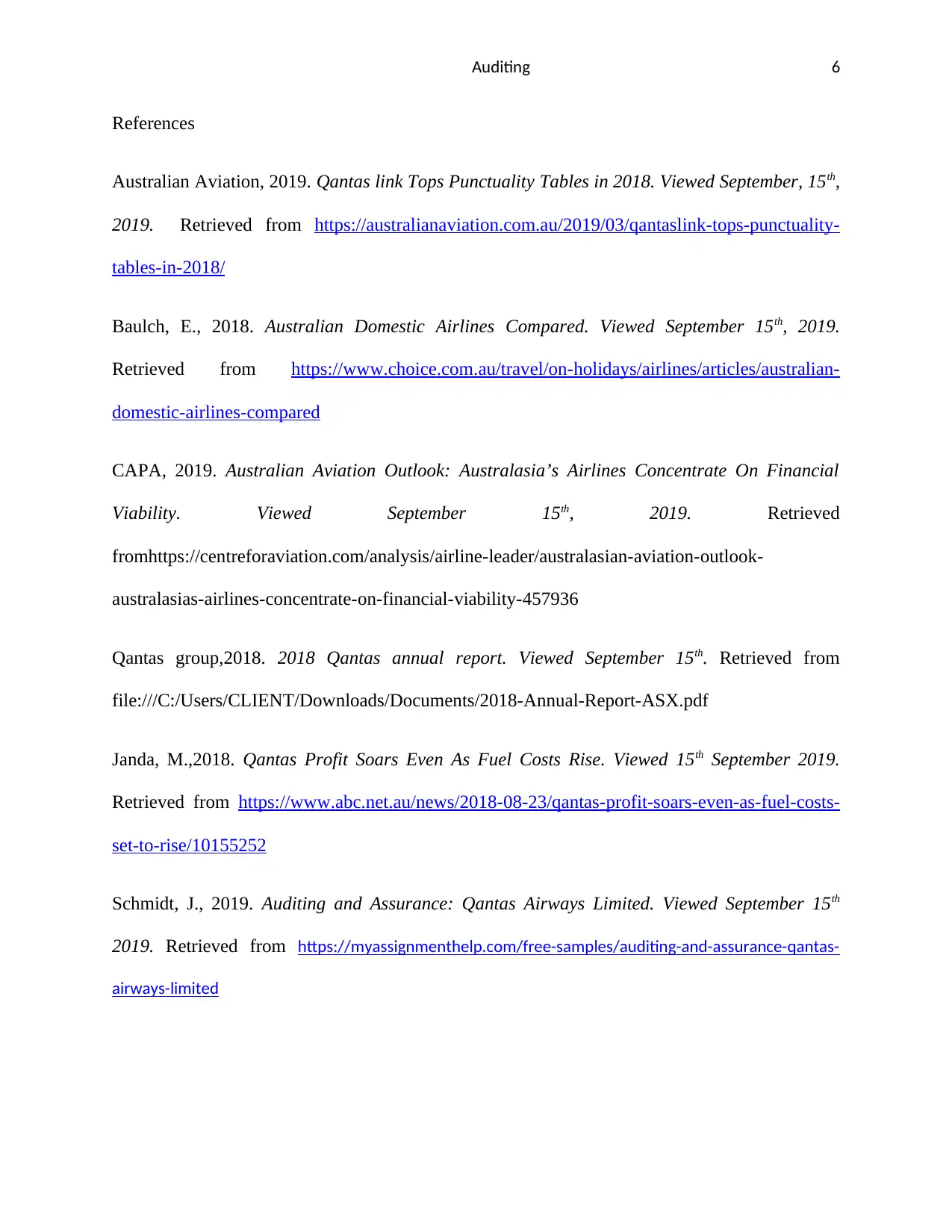
Auditing 6
References
Australian Aviation, 2019. Qantas link Tops Punctuality Tables in 2018. Viewed September, 15th,
2019. Retrieved from https://australianaviation.com.au/2019/03/qantaslink-tops-punctuality-
tables-in-2018/
Baulch, E., 2018. Australian Domestic Airlines Compared. Viewed September 15th, 2019.
Retrieved from https://www.choice.com.au/travel/on-holidays/airlines/articles/australian-
domestic-airlines-compared
CAPA, 2019. Australian Aviation Outlook: Australasia’s Airlines Concentrate On Financial
Viability. Viewed September 15th, 2019. Retrieved
fromhttps://centreforaviation.com/analysis/airline-leader/australasian-aviation-outlook-
australasias-airlines-concentrate-on-financial-viability-457936
Qantas group,2018. 2018 Qantas annual report. Viewed September 15th. Retrieved from
file:///C:/Users/CLIENT/Downloads/Documents/2018-Annual-Report-ASX.pdf
Janda, M.,2018. Qantas Profit Soars Even As Fuel Costs Rise. Viewed 15th September 2019.
Retrieved from https://www.abc.net.au/news/2018-08-23/qantas-profit-soars-even-as-fuel-costs-
set-to-rise/10155252
Schmidt, J., 2019. Auditing and Assurance: Qantas Airways Limited. Viewed September 15th
2019. Retrieved from https://myassignmenthelp.com/free-samples/auditing-and-assurance-qantas-
airways-limited
References
Australian Aviation, 2019. Qantas link Tops Punctuality Tables in 2018. Viewed September, 15th,
2019. Retrieved from https://australianaviation.com.au/2019/03/qantaslink-tops-punctuality-
tables-in-2018/
Baulch, E., 2018. Australian Domestic Airlines Compared. Viewed September 15th, 2019.
Retrieved from https://www.choice.com.au/travel/on-holidays/airlines/articles/australian-
domestic-airlines-compared
CAPA, 2019. Australian Aviation Outlook: Australasia’s Airlines Concentrate On Financial
Viability. Viewed September 15th, 2019. Retrieved
fromhttps://centreforaviation.com/analysis/airline-leader/australasian-aviation-outlook-
australasias-airlines-concentrate-on-financial-viability-457936
Qantas group,2018. 2018 Qantas annual report. Viewed September 15th. Retrieved from
file:///C:/Users/CLIENT/Downloads/Documents/2018-Annual-Report-ASX.pdf
Janda, M.,2018. Qantas Profit Soars Even As Fuel Costs Rise. Viewed 15th September 2019.
Retrieved from https://www.abc.net.au/news/2018-08-23/qantas-profit-soars-even-as-fuel-costs-
set-to-rise/10155252
Schmidt, J., 2019. Auditing and Assurance: Qantas Airways Limited. Viewed September 15th
2019. Retrieved from https://myassignmenthelp.com/free-samples/auditing-and-assurance-qantas-
airways-limited
⊘ This is a preview!⊘
Do you want full access?
Subscribe today to unlock all pages.

Trusted by 1+ million students worldwide
1 out of 6
Related Documents
Your All-in-One AI-Powered Toolkit for Academic Success.
+13062052269
info@desklib.com
Available 24*7 on WhatsApp / Email
![[object Object]](/_next/static/media/star-bottom.7253800d.svg)
Unlock your academic potential
Copyright © 2020–2025 A2Z Services. All Rights Reserved. Developed and managed by ZUCOL.




